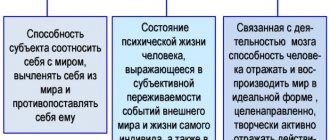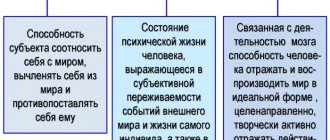Speech as the basic mental concept of its properties and functions
Tatiana Birulina
Speech as the basic mental concept of its properties and functions
Speech as a basic mental concept , its properties and functions
Speech between people using language constructs, the creation of which contains certain rules.
It should be noted that this concept is studied in the context of several disciplines, so there is no clearly formulated and final interpretation of it. Linguists interpret this word more narrowly: speech is a person’s knowledge and ability to use natural language. In general psychology, speech is a way of expressing and communicating to other people one’s internal, psychological states , thoughts and feelings. Speech also includes non-verbal means of communication: gestures, facial expressions, pantomime and other various means of exchanging information.
Speech is an integral element of human activity. Thanks to speech, a person learns about the world around him, shares his experience and knowledge with other people, both his own and subsequent generations. It is speech determines the mechanism for the development of thinking.
According to I.P. Pavlov, speech is a distinctive feature of human thinking, since it provides an opportunity to escape from reality and generalization.
Speaking (both oral and written)
has a number of characteristic features, including:
1) content, which consists in the number of thoughts, images and feelings expressed in speech, their significance and correspondence to reality;
2) clarity , achieved by syntactically correct construction of sentences, using pauses and logical stress when necessary to highlight words;
3) expressiveness - emotional richness, brightness, energy of speech, variety and richness of linguistic means;
4) effectiveness - the influence of speech on the behavior and beliefs of other people, their thoughts, feelings and will.
Forms of speech are “standard methods of structural and semantic organization of speech utterances based on the corresponding use of linguistic means of constructing speech messages.”
In the general structure of speech activity, there are three forms: external oral, external written and internal speech .
It should be noted that in general psychology and special pedagogy forms of speech are classified differently, depending on the criteria considered.
Based on the nature of the means of expressing thoughts used, oral speech (implemented by sound means), kinetic speech (includes expressive gestures and postures, most often used in conjunction with other forms of speech) and written speech are .
external speech differs (audible, articulated, hidden speech ( “to oneself”
, inner
speech (collapsed and predominantly predicative)
.
According to the degree of activity of the individual in planning and producing speech activity, speech is divided into active (planned completely independently), reactive (the interlocutor-partner partially and indirectly takes part in planning) and automated (with a complete absence of planning)
.
Researchers have identified several main functions performed by speech .
1. Communicative - the main function of speech , manifested in the transfer of information from one person to another or a group of people. There is an exchange of words that are perceived as separate concepts containing certain knowledge.
This function implies that people use speech in various types of joint activities as an organizing tool.
The communicative function of speech is divided into two subfunctions : messages, when a person expresses his opinion on any problem or characterizes his attitude towards any subject, and incentives to action, the effectiveness of which depends on the emotional expressiveness of speech.
2. The regulatory function of speech (was identified by L. S. Vygotsky and studied by A. R. Luria and other psychologists ) is realized in conscious forms mental activity - the so-called higher mental functions , which are voluntary. This function is manifested in the fact that people use speech to regulate the behavior of other people, as well as to master their own behavior, applying the same stimulus-signs to it. It is thanks to inner speech that a person is able to master his voluntary actions.
3. The programming function of speech consists in “constructing semantic schemes of a speech utterance, grammatical structures of sentences, in the transition from an idea to an external, detailed utterance. is based on internal programming, carried out using internal speech. As clinical data show, it is necessary not only for speech expression, but also for constructing a wide variety of movements and actions.”
Speech is closely integrated with all human mental processes ; it is language in action.
Functions
When researchers began to study the role of speech in society, they identified two functions of this ability - intellectual and communicative.
Intelligent
Speech acts as a means of education, development, and expression of thoughts. The unit of thinking and speech is the word. Each of them has its own meaning.
Communication
Speech is a tool of communication between people, allowing them to exchange information and encourage action. When creating messages, a person indicates a phenomenon or object in it. To evoke emotions in your interlocutor, you need to form the correct meaning.
The main purpose of verbal meanings is to convey thoughts. This is influenced by the choice of word, the emotional expression that relates to the sounds being spoken.
With the help of tone, facial expressions, intonation, imagery of expressions, selection of words, expression of feelings, you can express a thought. These techniques will help make the message more expressive, rich or faded and empty.
Theories
During the entire period of formation and development of the ability, various theories have been put forward regarding this communicative tool. Modern scientists supported constructivist, relativist, preformist theory.
Preformist
Preformist theory was proposed by N. Chomsky in 1968. The scientist argued that different languages of the world have a similar structure. The opinion of preformationists agree that the human brain contains an initial structure that is determined by heredity.
Therefore, a person can change the meaning of phrases, understand their meaning, and construct meaningful statements, the number of which is unlimited.
At the same time, preformists do not deny that the development potential of a child depends on his environment, interactions with loved ones, the use of upbringing and teaching methods (parents, kindergarten, school, various educational institutions).
Constructivist
Constructivist theory is popular among researchers. According to it, the formation and development of the ability depends on the child’s inherent ability to process and perceive information from birth. A confirming example of this theory is spontaneous word creation in children at an early age. It is believed that children's first words are related to facts that they already understand. In addition, they can speak out about what interests them. Motivation has a huge impact on the formation of ability.
Relativistic
Another popular theory is relativistic. According to it, different languages can be considered from the perspective of the culture of the people, the nation. Each culture has different ways of constructing language. Many scientists are confident that the general picture of worldview depends on the language a person speaks, but when studying the linguistic characteristics of different nationalities of the world, this statement was refuted.
History of the study and researchers
It is believed that the first articulate speech appeared about two million years ago. Then the first people developed a speech apparatus.
Psycholinguistics is a branch of psychological science that was formed under the influence of linguistics. Its goal is to study the relationships between consciousness, thinking, and language.
The term “speech” was proposed by the famous American psychologist J.R. Cantor. It became widely used among other researchers after Kantor’s student N. G. Pronko used it in the article “Language and Psycholinguistics.”
One of the main hypotheses that played a huge role in the formation and development of psycholinguistics is the hypothesis of linguistic relativity. After its publication, the scientific world began to actively raise the question of the relationship between thinking and language.
The next scientist who made a huge contribution to the study of speech was N. Chomsky. In his works, he described the work of language when constructing phrases and sentences.
The domestic psychologist who made a great contribution to the development of this direction of psychological science is L. S. Vygotsky. He formed a sequence of actions before reproducing the words. It consists of several elements:
- motivation;
- formation of thoughts;
- internal construction of the sentence;
- choice of words;
- implementation.
Construction and playback stages
There are several stages of speech construction:
- Formation of thoughts and statements.
- Construction of inner speech. At this stage, the individual thinks about how to convey the idea to the interlocutor.
- Selecting individual or related phrases, assumptions, forming beliefs.
- Selecting individual words, morphemes, composing complete sentences.
The last stage is reproduction of the generated text. For this, different sound signals are used. Speech is supplemented by facial expressions, gestures, changes in tempo, timbre and tone of voice, and emphasis on individual words.
Study methods
To study abilities, psychologists and linguists use different methods:
- Observation. The total time spent on conversations with others and monologues, gestures, facial expressions, changes in tone, tempo, and expressiveness is taken into account. When observing, natural thinking is maintained, which is a huge advantage.
- Conversation. An effective method for studying ability. With its help, you can find out the interlocutor’s attitude to the assigned task, evaluate mental capabilities, and learn language skills. During the conversation, direct or indirect questions may be asked.
- Experiment. Researchers create conditions for the subject and change them to obtain information. Additionally, data on brain function can be read using specialized equipment.
- Questioning. Used to study thinking. Questionnaires are prepared in advance, questions are selected on one or more topics of interest. A detailed result is given by open-ended questionnaires that force the subject to activate his thinking.
- Testing. Allows you to measure the level of intellectual development and find out the features of thinking.
Researchers analyze the data obtained and draw conclusions.
Prevention of speech disorders. Helping a child at home
To prevent violations and for the general development of speech, constant communication is needed. Otherwise, problems will arise sooner or later, even if there were no medical prerequisites initially. A child learning a language must practice through regular contact with native speakers. And the carriers are you. Communication is an integral part of the education program.
What's useful:
- read together with your child, talk about what you read, illustrate the plot together, discuss the drawings;
- sing songs together;
- listen to the little why, without interrupting, answer his questions about the world around him, teach him to listen to others;
- correct errors in the pronunciation of words and sounds, find the correct analogues for “baby” words and “lisping” (“bobo”, “kaka”).
Mistakes that many people make, but I want to believe you don’t:
- the child’s questions are answered with the general “when you grow up, you’ll know” and “because it ends in U”;
- do little socializing and reading aloud; so that the child is not distracted from his work, they turn on cartoons for the whole day and leave him alone with the TV or computer;
- They repeat with tenderness after the baby everything that he babbles, thereby contributing to the reinforcement of incorrect words and illiterate pronunciation - they impoverish the speech of the future native speaker of the Russian language.
From a “technical” point of view, breathing exercises and tongue exercises are always beneficial. Breathing can be trained using play methods that are interesting to the child: blowing soap bubbles and balloons, learning to play toy flutes and harmonicas. There are standard articulation exercises for practicing various problem sounds, when the tongue, lips and teeth are held for 10-20 seconds in certain positions:
- sound “R” - mouth wide open, tongue at the upper jaw, tapping on the teeth while pronouncing the sound “D”;
- hissing - the lips are extended forward as much as possible, the jaws are closed;
- whistling - the end of the tongue rests against the front teeth of the lower jaw, and the edges against the far teeth of the upper jaw.
When we are talking not about prevention, but about the correction of already established deviations, the work is carried out more deeply, according to individual programs, with the regular participation of a speech therapist. If your child has clear signs of a speech disorder, but you cannot understand the reasons and what to do next, we suggest that you undergo a comprehensive diagnosis of speech disorders at our Center. To make an appointment for an examination and an appointment with a speech therapist, call tel. or use the online registration form on the website e.










